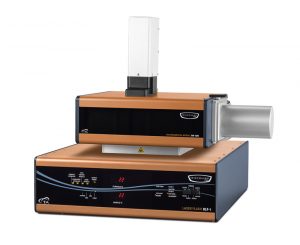
Powerful laser flash performance in a compact, affordable benchtop design.
The Discovery Laser Flash DLF 1200 is a compact benchtop instrument for the measurement of thermal diffusivity, thermal conductivity, and specific heat capacity of materials from room temperature to 1200˚C. It features a proprietary laser source with 17 Joules of energy for testing of the widest range of samples under the most demanding conditions. Productivity is no problem with the four-sample tray design. It is the only benchtop light flash instrument available with a laser pulse source for enhanced precision, accuracy and capabilities beyond competitive Xenon light source designs.
DLF 1200 Features
- Powerful laser, with 65% higher energy compared to competitive Xenon systems, for the most accurate testing of the widest range of samples, regardless of thickness and thermal conductivity to 1200˚C
- Laser is inherently coherent and precisely irradiates only the sample surface, eliminating the need to correct for lateral heat transfer from over-flash onto sample holder
- Autosampler with patented four-position alumina sample tray for maximum productivity
- Wide variety of sample trays accommodates multiple sample sizes (up to 25.4 mm), shapes, and special fixtures (liquids, powders, laminates, films, etc.) for maximum sample testing flexibility
- Advanced resistance heated furnace provides best-in-class temperature stability and uniformity across sample from RT to 1200˚C and enables measurements in air, inert gas, or vacuum
- High sensitivity IR detector for optimum signal-to-noise ratio, delivering highest accuracy over the entire temperature range
- Real-time pulse mapping for superior thermal diffusivity of thin and highly conductive materials
- Designed to meet industry standard test methods including ASTM E1461, ASTM C714, ASTM E2585, ISO 13826, ISO 22007-Part4, ISO 18755, BS ENV 1159-2, DIN 30905, and DIN EN821
Laser Source
| Type | Class 1Nd: Glass, Benchtop |
| Pulse Energy (Variable) | Up to 17 Joules |
| Pulse Width | 300 µs to 400 µsec |
| Proprietary Transfer Optics | Optic Beam Guide |
Furnace
| Temperature Range | RT to 1200°C |
| Atmosphere | Air, inert, vacuum (50 mtorr) |
Detection
| Thermal Diffusivity Range | 0.01 to 1000 mm2/s |
| Thermal Conductivity Range | 0.1 to 2000 W/(m*K) |
| Data Acquisition | 16 bit |
Accuracy
| Thermal Diffusivity | ±2.3% |
| Thermal Conductivity | ±4% |
Repeatability
| Thermal Diffusivity | ±2.0% |
| Thermal Conductivity | ±3.5% |
Sample
| Round | 8, 10, 12.7, & 25.4 mm Diameter |
| Square | 8 & 10 mm length |
| Maximum Thickness | 10 mm |
Autosampler
| Type | Four-Position Linear Tray |
Collimated, High Energy Laser Source
Collimated, High Energy Laser Source
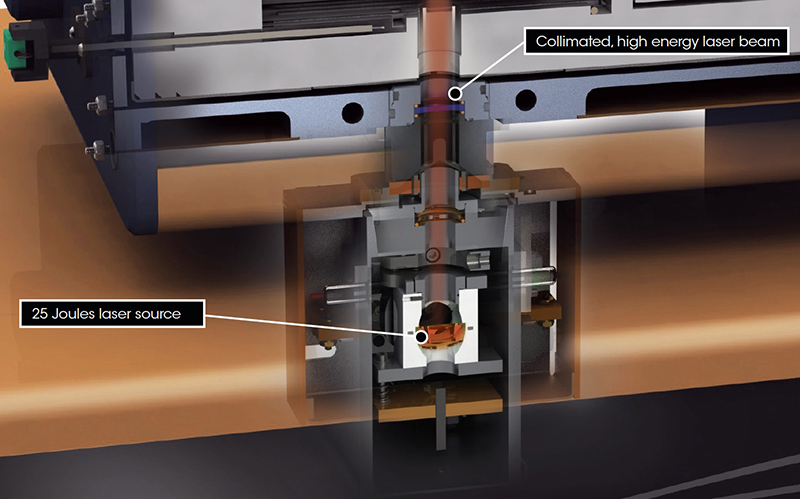
The DLF 1200 pulse source is a Class I Neodymium:Glass (Nd:glass) laser with 17 Joules of energy. It delivers an inherently collimated, monochromatic pulse to the sample surface. More light pulse energy delivered to the surface of sample during a measurement means enhanced signal quality at the detector. Only the DLF 1200 can supply 17 Joules of power, providing significant benefits in a benchtop light flash design. With 65% more energy than Xenon Flash instrument designs, thicker samples, or samples of low conductivity or surface emissivity (shiny surface), are more easily tested. The higher power enables more accurate testing to 1200°C, further extending the capabilities beyond Xenon light designs.
Efficient Energy Delivery Without Complex Optics
Efficient Energy Delivery Without Complex Optics
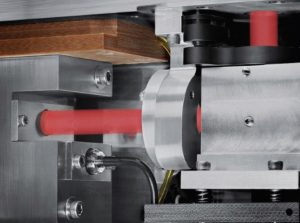 The DLF 1200 laser is in close proximity to the sample, which ensures the efficient delivery of an inherently coherent pulse to the surface of the specimen. The result is a homogeneous, high quality radiation pulse precisely focused on the sample. The design eliminates the need for complex optics to collimate and deliver light as required by Xenon light systems.
The DLF 1200 laser is in close proximity to the sample, which ensures the efficient delivery of an inherently coherent pulse to the surface of the specimen. The result is a homogeneous, high quality radiation pulse precisely focused on the sample. The design eliminates the need for complex optics to collimate and deliver light as required by Xenon light systems.
Reliable Temperature Control and Uniformity to 1200°C
Reliable Temperature Control and Uniformity to 1200°C
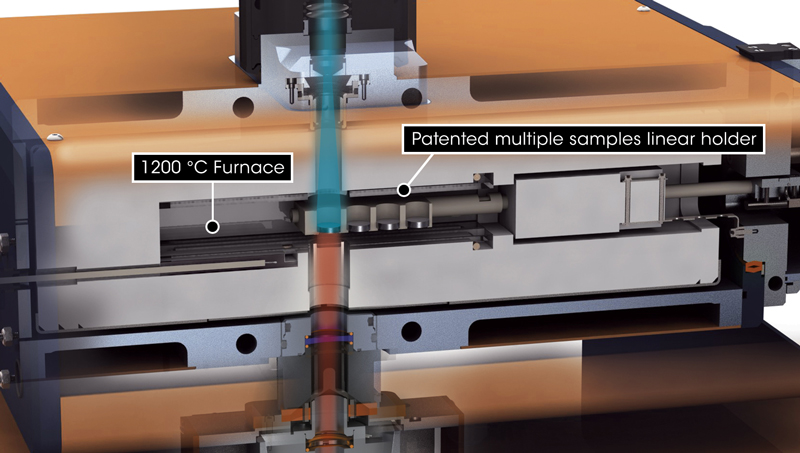
The DLF 1200 features a rugged and reliable resistance heated furnace with superior temperature precision and uniformity. The ability of the furnace to precisely control temperature to the target value, especially at high temperatures above 1000˚C, ensures the small 1 to 2 degree temperature rise that occurs during the energy pulse is properly detected for the most accurate measurement of thermal diffusivity. The uniform heating across the entire four-position sample tray greatly improves repeatability within the same test run, and guarantees unknown samples and specific heat reference standards are tested under the exact same thermal circumstance for the highest quality thermal conductivity determination. The furnace can be operated in air, inert gas, or vacuum.
Reliable Automation
Reliable Automation
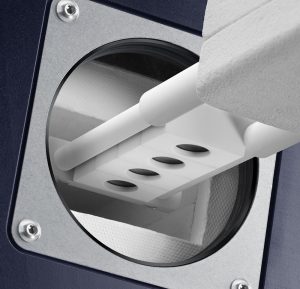 The DLF 1200 comes standard with a patented* linear autosampler greatly improving lab productivity. The autosampler can be configured with various sample trays that can accommodate four round or square samples up to 12.7 mm in diameter or length, or two samples up to 25.4 mm in size. Maximum sample thickness is 10 mm. In addition, application specific fixtures for liquids, powders, laminates, and in-plane analysis for thin films and materials of very high diffusivity are available. The system offers full flexibility enabling combinations of the various fixtures to be simultaneously loaded onto the autosampler tray.
The DLF 1200 comes standard with a patented* linear autosampler greatly improving lab productivity. The autosampler can be configured with various sample trays that can accommodate four round or square samples up to 12.7 mm in diameter or length, or two samples up to 25.4 mm in size. Maximum sample thickness is 10 mm. In addition, application specific fixtures for liquids, powders, laminates, and in-plane analysis for thin films and materials of very high diffusivity are available. The system offers full flexibility enabling combinations of the various fixtures to be simultaneously loaded onto the autosampler tray.
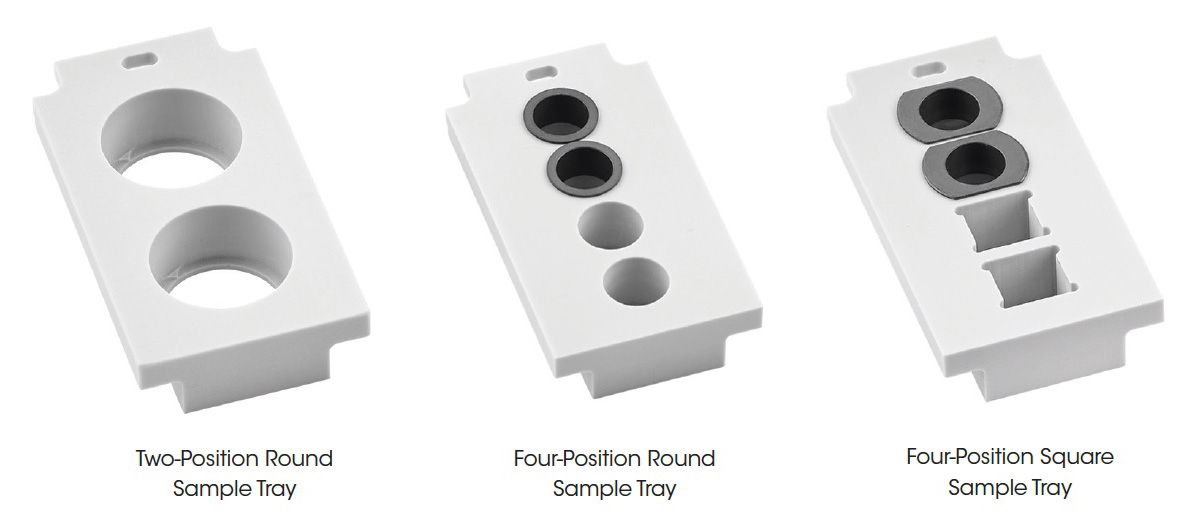
*US Patent No. 6,375,349 B1
The Benefits of a Powerful Laser for Data Accuracy
The Benefits of a Powerful Laser for Data Accuracy
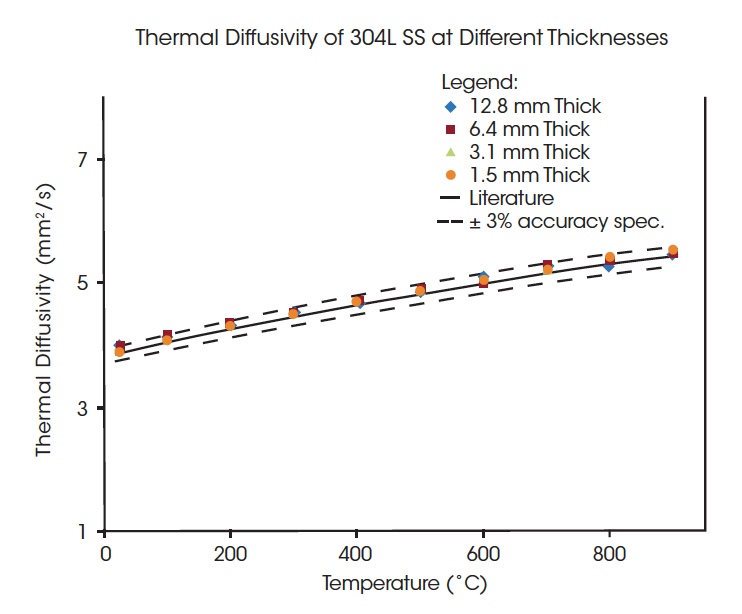
Accuracy defines how close a set of measured data are to the true value. It is typically assessed by repeatedly testing the same sample under the same conditions and comparing results to reference data. For a light flash instrument, the ability to make an accurate measurement relies on all design components working together efficiently as a system. These components include the light source, the pulse delivery, the detector, and the furnace. A laser light source provides a system advantage because of the power of the light pulse. As the thickness of a sample increases, laser power is important as more energy is required to transfer through the sample and detect a temperature rise on the opposite side.
To demonstrate the superior capabilities of the DLF 1200, four samples of a very well- characterized material, stainless steel 304L, ranging from approximately 1 to 10 mm in thickness were tested and compared to the literature values.
In the graph on the upper right, the thermal diffusivity results for the four samples are shown in comparison to the literature values for the stainless steel along with error bars of ±3% of the literature value. The accuracy is consistently better than the instrument specification of 3% for samples spanning an order of magnitude in thickness demonstrating the superior performance of the world’s most powerful benchtop light flash instrument.
High Quality Thermal Conductivity
High Quality Thermal Conductivity
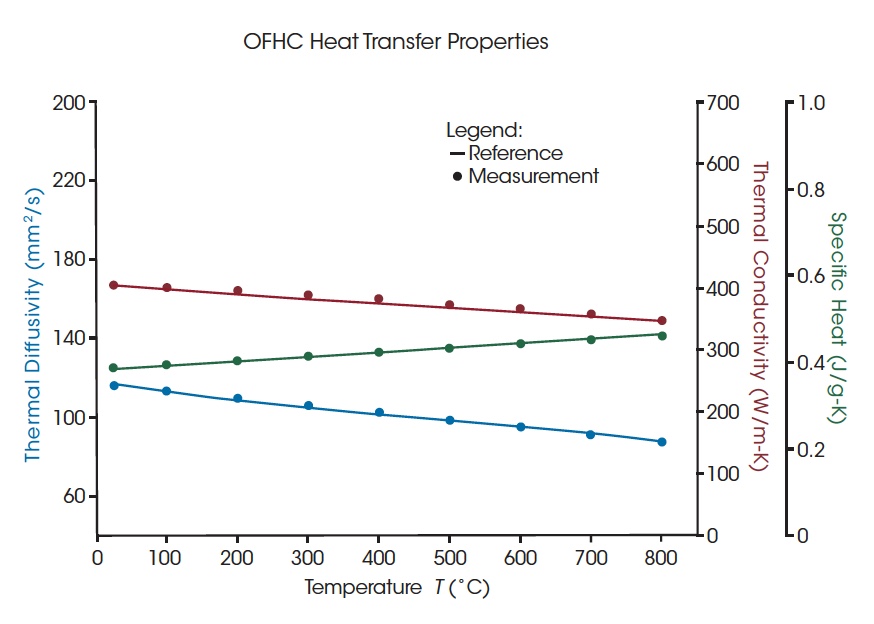
Oxygen-free high thermal conductivity copper (OFHC) is a well-characterized material typically used as a reference sample when evaluating the quality of measurements of thermophysical properties from light flash instruments. The figure on the lower right displays the thermal diffusivity, specific heat, and thermal conductivity of OFHC copper samples tested on the DLF1200. The thermal diffusivity and specific heat results are in excellent agreement with the reference values over the entire applicable temperature range. The high quality of these results in turn provides outstanding calculated results of the thermal conductivity within 3% of the expected data.
Reliable Results with Patented Autosampler
Reliable Results with Patented Autosampler
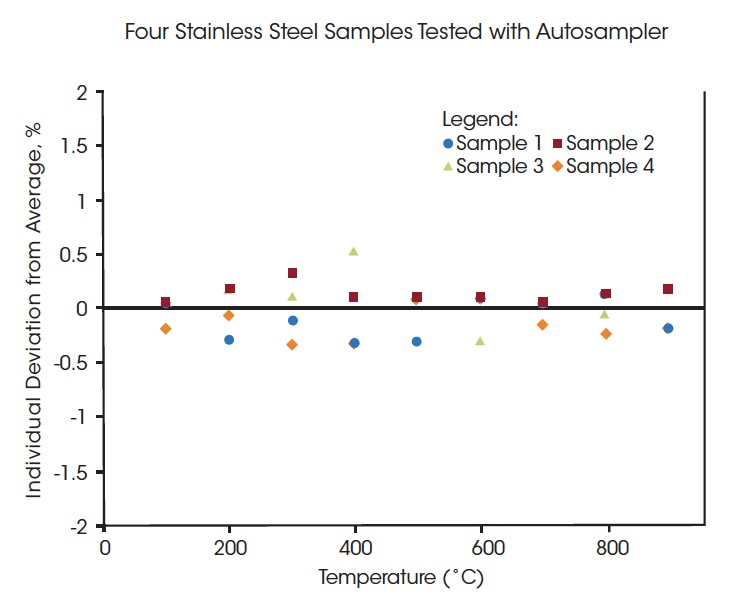
When conducting flash measurements, alignment of the sample in the path of the light pulse and detector is critical for obtaining accurate results. The patented linear four-position autosampler of the DLF 1200 was designed for precision positioning of each sample in succession to ensure this condition is met. The graph to the right shows four samples of stainless steel loaded in the autosampler and tested in sequence from ambient to 900°C. All the thermal diffusivity values are within ±0.5% of the expected value, well below the repeatability specification of ±2%. Various configurations of Autosampler trays are shown below.
The Proven Software Platform for Easy, Accurate Flash Analysis Data
 All Discovery Light Flash instruments include FlashLine™ software for Instrument Control and Data Analysis. The Microsoft Windows based software features an intuitive tablebased format for simple programming of experimental parameters in the instrument control interface. Real-time monitoring allows for immediate assessment of the data quality and instrument performance during each test. The Data Analysis module’s automated routines provide users with advanced analysis tools, including models for heat loss correction in both conduction and radiation.
All Discovery Light Flash instruments include FlashLine™ software for Instrument Control and Data Analysis. The Microsoft Windows based software features an intuitive tablebased format for simple programming of experimental parameters in the instrument control interface. Real-time monitoring allows for immediate assessment of the data quality and instrument performance during each test. The Data Analysis module’s automated routines provide users with advanced analysis tools, including models for heat loss correction in both conduction and radiation.
Integrated with the pulse-shape mapping measuring system, FlashLine determines the exact shape of the laser pulse versus time to make pulse shape and width correction. It also identifies the flash zero origin and enables finite pulse effect correction which is critical to guarantee accurate measurements for thin samples and high-diffusivity materials. Additionally, the TA Instrument developed “Goodness of Fit” evaluation tool allows the user to select the best results calculated by different Thermal Diffusivity models.
Software Features:
- Unlimited temperature segments with user-defined heat ramp steps
- User-selectable laser energy for each sample by temperature segment
- Data analysis of any already-completed segment during testing
- Determination of the specific heat by comparative method
- Option for automatic multiple-shots selection and averaging
- Correction for radiation component of transparent and translucent samples
- Automatic optimization of flash energy level
- Option for sample skip, and precision criterion
- Fast zoom function for X and Y segments
- Thermal diffusivity, specific heat, and thermal conductivity tables and graphs as a function of temperature
- Calculations of all models during testing and available by the completion of testing
Standard models include:
- Gembarovic for multi-dimensional heat loss correction and non-linear regression
- Goodness of Fit for the best model result selection
- Pulse gravity center to determine t0
- Pulse length and shape correction
- Two and three layers analysis
- In-plane
- Main models: Clark and Taylor, Cowan, Degiovanni, Koski, Least Squares, Logarithmic, Moment, Heckman, Azumi, and Parker
- Description
-
The Discovery Laser Flash DLF 1200 is a compact benchtop instrument for the measurement of thermal diffusivity, thermal conductivity, and specific heat capacity of materials from room temperature to 1200˚C. It features a proprietary laser source with 17 Joules of energy for testing of the widest range of samples under the most demanding conditions. Productivity is no problem with the four-sample tray design. It is the only benchtop light flash instrument available with a laser pulse source for enhanced precision, accuracy and capabilities beyond competitive Xenon light source designs.
- Features
-
DLF 1200 Features
- Powerful laser, with 65% higher energy compared to competitive Xenon systems, for the most accurate testing of the widest range of samples, regardless of thickness and thermal conductivity to 1200˚C
- Laser is inherently coherent and precisely irradiates only the sample surface, eliminating the need to correct for lateral heat transfer from over-flash onto sample holder
- Autosampler with patented four-position alumina sample tray for maximum productivity
- Wide variety of sample trays accommodates multiple sample sizes (up to 25.4 mm), shapes, and special fixtures (liquids, powders, laminates, films, etc.) for maximum sample testing flexibility
- Advanced resistance heated furnace provides best-in-class temperature stability and uniformity across sample from RT to 1200˚C and enables measurements in air, inert gas, or vacuum
- High sensitivity IR detector for optimum signal-to-noise ratio, delivering highest accuracy over the entire temperature range
- Real-time pulse mapping for superior thermal diffusivity of thin and highly conductive materials
- Designed to meet industry standard test methods including ASTM E1461, ASTM C714, ASTM E2585, ISO 13826, ISO 22007-Part4, ISO 18755, BS ENV 1159-2, DIN 30905, and DIN EN821
- Specifications
-
Laser Source
Type Class 1Nd: Glass, Benchtop Pulse Energy (Variable) Up to 17 Joules Pulse Width 300 µs to 400 µsec Proprietary Transfer Optics Optic Beam Guide Furnace
Temperature Range RT to 1200°C Atmosphere Air, inert, vacuum (50 mtorr) Detection
Thermal Diffusivity Range 0.01 to 1000 mm2/s Thermal Conductivity Range 0.1 to 2000 W/(m*K) Data Acquisition 16 bit Accuracy
Thermal Diffusivity ±2.3% Thermal Conductivity ±4% Repeatability
Thermal Diffusivity ±2.0% Thermal Conductivity ±3.5% Sample
Round 8, 10, 12.7, & 25.4 mm Diameter Square 8 & 10 mm length Maximum Thickness 10 mm Autosampler
Type Four-Position Linear Tray - Technology
-
Collimated, High Energy Laser Source
Collimated, High Energy Laser Source

The DLF 1200 pulse source is a Class I Neodymium:Glass (Nd:glass) laser with 17 Joules of energy. It delivers an inherently collimated, monochromatic pulse to the sample surface. More light pulse energy delivered to the surface of sample during a measurement means enhanced signal quality at the detector. Only the DLF 1200 can supply 17 Joules of power, providing significant benefits in a benchtop light flash design. With 65% more energy than Xenon Flash instrument designs, thicker samples, or samples of low conductivity or surface emissivity (shiny surface), are more easily tested. The higher power enables more accurate testing to 1200°C, further extending the capabilities beyond Xenon light designs.
Efficient Energy Delivery Without Complex Optics
Efficient Energy Delivery Without Complex Optics
 The DLF 1200 laser is in close proximity to the sample, which ensures the efficient delivery of an inherently coherent pulse to the surface of the specimen. The result is a homogeneous, high quality radiation pulse precisely focused on the sample. The design eliminates the need for complex optics to collimate and deliver light as required by Xenon light systems.
The DLF 1200 laser is in close proximity to the sample, which ensures the efficient delivery of an inherently coherent pulse to the surface of the specimen. The result is a homogeneous, high quality radiation pulse precisely focused on the sample. The design eliminates the need for complex optics to collimate and deliver light as required by Xenon light systems.
Reliable Temperature Control and Uniformity to 1200°C
Reliable Temperature Control and Uniformity to 1200°C

The DLF 1200 features a rugged and reliable resistance heated furnace with superior temperature precision and uniformity. The ability of the furnace to precisely control temperature to the target value, especially at high temperatures above 1000˚C, ensures the small 1 to 2 degree temperature rise that occurs during the energy pulse is properly detected for the most accurate measurement of thermal diffusivity. The uniform heating across the entire four-position sample tray greatly improves repeatability within the same test run, and guarantees unknown samples and specific heat reference standards are tested under the exact same thermal circumstance for the highest quality thermal conductivity determination. The furnace can be operated in air, inert gas, or vacuum.
Reliable Automation
Reliable Automation
 The DLF 1200 comes standard with a patented* linear autosampler greatly improving lab productivity. The autosampler can be configured with various sample trays that can accommodate four round or square samples up to 12.7 mm in diameter or length, or two samples up to 25.4 mm in size. Maximum sample thickness is 10 mm. In addition, application specific fixtures for liquids, powders, laminates, and in-plane analysis for thin films and materials of very high diffusivity are available. The system offers full flexibility enabling combinations of the various fixtures to be simultaneously loaded onto the autosampler tray.
The DLF 1200 comes standard with a patented* linear autosampler greatly improving lab productivity. The autosampler can be configured with various sample trays that can accommodate four round or square samples up to 12.7 mm in diameter or length, or two samples up to 25.4 mm in size. Maximum sample thickness is 10 mm. In addition, application specific fixtures for liquids, powders, laminates, and in-plane analysis for thin films and materials of very high diffusivity are available. The system offers full flexibility enabling combinations of the various fixtures to be simultaneously loaded onto the autosampler tray.
*US Patent No. 6,375,349 B1
- Performance
-
The Benefits of a Powerful Laser for Data Accuracy
The Benefits of a Powerful Laser for Data Accuracy

Accuracy defines how close a set of measured data are to the true value. It is typically assessed by repeatedly testing the same sample under the same conditions and comparing results to reference data. For a light flash instrument, the ability to make an accurate measurement relies on all design components working together efficiently as a system. These components include the light source, the pulse delivery, the detector, and the furnace. A laser light source provides a system advantage because of the power of the light pulse. As the thickness of a sample increases, laser power is important as more energy is required to transfer through the sample and detect a temperature rise on the opposite side.
To demonstrate the superior capabilities of the DLF 1200, four samples of a very well- characterized material, stainless steel 304L, ranging from approximately 1 to 10 mm in thickness were tested and compared to the literature values.
In the graph on the upper right, the thermal diffusivity results for the four samples are shown in comparison to the literature values for the stainless steel along with error bars of ±3% of the literature value. The accuracy is consistently better than the instrument specification of 3% for samples spanning an order of magnitude in thickness demonstrating the superior performance of the world’s most powerful benchtop light flash instrument.
High Quality Thermal Conductivity
High Quality Thermal Conductivity

Oxygen-free high thermal conductivity copper (OFHC) is a well-characterized material typically used as a reference sample when evaluating the quality of measurements of thermophysical properties from light flash instruments. The figure on the lower right displays the thermal diffusivity, specific heat, and thermal conductivity of OFHC copper samples tested on the DLF1200. The thermal diffusivity and specific heat results are in excellent agreement with the reference values over the entire applicable temperature range. The high quality of these results in turn provides outstanding calculated results of the thermal conductivity within 3% of the expected data.
Reliable Results with Patented Autosampler
Reliable Results with Patented Autosampler

When conducting flash measurements, alignment of the sample in the path of the light pulse and detector is critical for obtaining accurate results. The patented linear four-position autosampler of the DLF 1200 was designed for precision positioning of each sample in succession to ensure this condition is met. The graph to the right shows four samples of stainless steel loaded in the autosampler and tested in sequence from ambient to 900°C. All the thermal diffusivity values are within ±0.5% of the expected value, well below the repeatability specification of ±2%. Various configurations of Autosampler trays are shown below.
- Software
-
The Proven Software Platform for Easy, Accurate Flash Analysis Data
 All Discovery Light Flash instruments include FlashLine™ software for Instrument Control and Data Analysis. The Microsoft Windows based software features an intuitive tablebased format for simple programming of experimental parameters in the instrument control interface. Real-time monitoring allows for immediate assessment of the data quality and instrument performance during each test. The Data Analysis module’s automated routines provide users with advanced analysis tools, including models for heat loss correction in both conduction and radiation.
All Discovery Light Flash instruments include FlashLine™ software for Instrument Control and Data Analysis. The Microsoft Windows based software features an intuitive tablebased format for simple programming of experimental parameters in the instrument control interface. Real-time monitoring allows for immediate assessment of the data quality and instrument performance during each test. The Data Analysis module’s automated routines provide users with advanced analysis tools, including models for heat loss correction in both conduction and radiation.Integrated with the pulse-shape mapping measuring system, FlashLine determines the exact shape of the laser pulse versus time to make pulse shape and width correction. It also identifies the flash zero origin and enables finite pulse effect correction which is critical to guarantee accurate measurements for thin samples and high-diffusivity materials. Additionally, the TA Instrument developed “Goodness of Fit” evaluation tool allows the user to select the best results calculated by different Thermal Diffusivity models.
Software Features:
- Unlimited temperature segments with user-defined heat ramp steps
- User-selectable laser energy for each sample by temperature segment
- Data analysis of any already-completed segment during testing
- Determination of the specific heat by comparative method
- Option for automatic multiple-shots selection and averaging
- Correction for radiation component of transparent and translucent samples
- Automatic optimization of flash energy level
- Option for sample skip, and precision criterion
- Fast zoom function for X and Y segments
- Thermal diffusivity, specific heat, and thermal conductivity tables and graphs as a function of temperature
- Calculations of all models during testing and available by the completion of testing
Standard models include:
- Gembarovic for multi-dimensional heat loss correction and non-linear regression
- Goodness of Fit for the best model result selection
- Pulse gravity center to determine t0
- Pulse length and shape correction
- Two and three layers analysis
- In-plane
- Main models: Clark and Taylor, Cowan, Degiovanni, Koski, Least Squares, Logarithmic, Moment, Heckman, Azumi, and Parker





